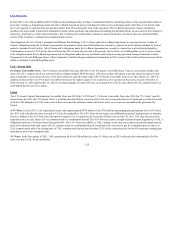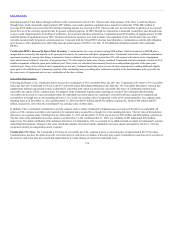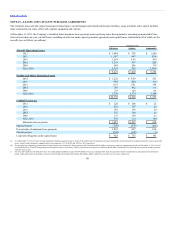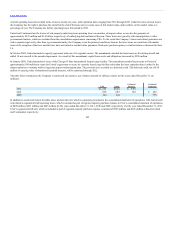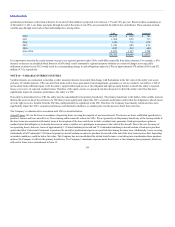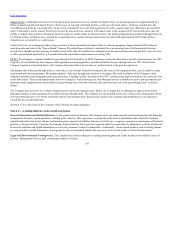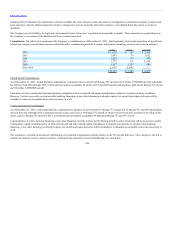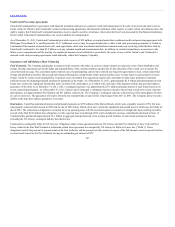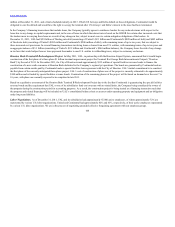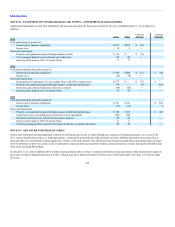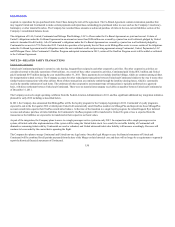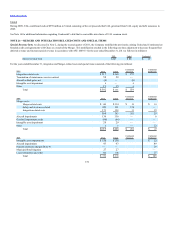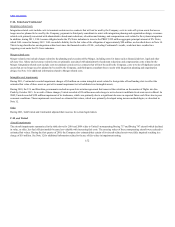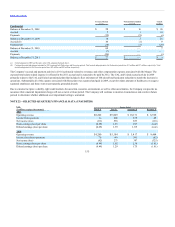United Airlines 2011 Annual Report Download - page 146
Download and view the complete annual report
Please find page 146 of the 2011 United Airlines annual report below. You can navigate through the pages in the report by either clicking on the pages listed below, or by using the keyword search tool below to find specific information within the annual report.
Table of Contents
Airport Leases. Continental is the lessee of real property under long-term leases at a number of airports where it is also the guarantor of approximately $1.6
billion of underlying debt and interest thereon. These leases are typically with municipalities or other governmental entities, which are excluded from the
consolidation requirements concerning VIEs. To the extent Continental’s lease and related guarantee are with a separate legal entity other than a governmental
entity, Continental is not the primary beneficiary because the lease terms are consistent with market terms at the inception of the lease and the lease does not
include a residual value guarantee, fixed-price purchase option or similar feature as discussed above. The leasing arrangements associated with approximately
$1.4 billion of these obligations are accounted for as operating leases, and the leasing arrangements associated with approximately $200 million of these
obligations are accounted for as capital leases.
United is the lessee of real property under a long-term lease at Denver International Airport where it is also the guarantor of approximately $270 million of
underlying debt and interest (the “Denver Bonds”) thereon. The related lease obligation is accounted for as an operating lease with the associated expense
recorded on a straight-line basis resulting in ratable accrual of the final $270 million lease obligation over the expected lease term through 2032. Since the lease
is with a governmental organization, it is excluded from the consolidation requirements concerning VIEs.
EETCs. The Company evaluated whether the pass-through trusts formed for its EETC financings, treated as either debt or aircraft operating leases, are VIEs
required to be consolidated by the Company under applicable accounting guidance, and determined that the pass-through trusts are VIEs. Based on the
Company’s analysis as described below, the Company determined that it does not have a variable interest in the pass-through trusts.
The primary risk of the pass-through trusts is credit risk (i.e. the risk that United or Continental, the issuer of the equipment notes, may be unable to make
its principal and interest payments). The primary purpose of the pass-through trust structure is to enhance the credit worthiness of the Company’s debt
obligation through certain bankruptcy protection provisions, a liquidity facility (in certain of the EETC structures) and improved loan-to-value ratios for more
senior debt classes. These credit enhancements lower the Company’s total borrowing cost. Pass-through trusts are established to receive principal and interest
payments on the equipment notes purchased by the pass-through trusts from the Company and remit these proceeds to the pass-through trusts’ certificate
holders.
The Company does not invest in or obtain a financial interest in the pass-through trusts. Rather, the Company has an obligation to make its interest and
principal payments on their equipment notes held by the pass-through trusts. The Company was not intended to have any voting or non-voting equity interest
in the pass-through trusts or to absorb variability from the pass-through trusts. Based on this analysis, the Company determined that it is not required to
consolidate the pass-through trusts.
See Note 17 for a discussion of the Company’s fuel consortia and other guarantees.
General Guarantees and Indemnifications. In the normal course of business, the Company enters into numerous real estate leasing and aircraft financing
arrangements that have various guarantees included in the contracts. These guarantees are primarily in the form of indemnities under which the Company
typically indemnifies the lessors and any tax/financing parties against tort liabilities that arise out of the use, occupancy, operation or maintenance of the leased
premises or financed aircraft. Currently, the Company believes that any future payments required under these guarantees or indemnities would be immaterial,
as most tort liabilities and related indemnities are covered by insurance (subject to deductibles). Additionally, certain leased premises such as fueling stations
or storage facilities include indemnities of such parties for any environmental liability that may arise out of or relate to the use of the leased premises.
Legal and Environmental Contingencies. The Company has certain contingencies resulting from litigation and claims incident to the ordinary course of
business. Management believes, after considering a number of factors,
145


